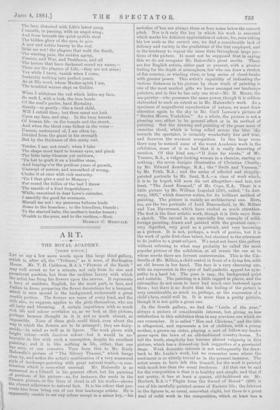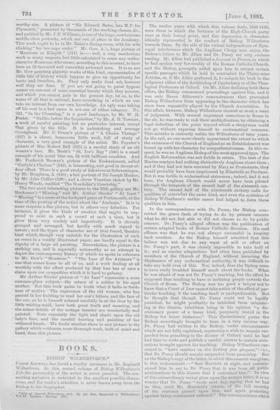ART.
THE ROYAL ACADEMY.
[THIRD NOTICE.]
.LET us say a few more words upon this large third gallery, 'which is, after all, the "Tribune," as it were, of Burlington House. Mr. T. H. Calderon, R.A.'s "Flowers of the Earth" may well arrest us for a minute, not only from its size and Prominent position, but from the reckless luxury with which the artist has flung his flowers upon the canvas. It represents -a bevy of maidens, English, for the most part, iu face, and Italian in dress, preparing the flower decorations for a banquet, which is seen spread in the background, underneath a great marble portico. The flowers are roses of every kind, and the .title also, we suppose, applies to the girls themselves, who are -all lusty and blooming. A certain impatience with so much rich life and colour overtakes us, as wo look at this picture, Perhaps because thought in it is not so much absent, as impossible. None of these girls could think, even about the way in which the flowers are to be arranged ; they are dairy- maids,—in mind as well as in figure. The work glows with .bright colour—with luscious colour—but it would be un-) bearable to live with such a conception, despite its excellent ,painting; and it is like nothing it life, either, that one has seen, or can conceive. Turn from this to Mr. Feely Halswelle's picture of " The Silvery Thames," which hangs close by, and notice the artist's combination of a very mannered sstyle of landscape-painting with great natural truth,—a com-
• bination which is somewhat unusual. Mr. Halswelle is as mannered as a Lianal in his general effect, but his painting • of portions of his picture—as, for instance, the reeds in the Thames picture, or the lines of cloud in all his works—shows the closest adherence to natural fact. It is his colour that pre- vents him from being one of our first landscape artists. He is .apparently unable to see any colour except in a minor key,—his
melodies of 'hue are always three or four notes below the concert. pitch. Nor is it only the key in which his work is executed
which marks his deficient appreciation of colour, for, even taking his low scale as the correct one, we find a considerable lack of delicacy and variety in the gradations of the tint employed, and in the tendency to repeat the same tints throughout large por- tions of the picture. It must not be supposed that in saying this we do not recognise Mr. Halswelle's great merits. There are few English artists, either past or present, with a greater feeling for the depth of atmosphere, few who can draw a stretch of fiat country, or winding river, or long series of cloud-banks with greater power. This artist's capability of indicating the various distances in his picture by sheer truth of painting is one of the most marked gifts we know amongst our landscape painters, and in this ho has only one rival—Mr. H. Moore, the sea-painter—who possesses the same power, though it is seldom elaborated to such an extent as in Mr. Halswelle's work. As a specimen of magnificent reproduction of nature, we must draw attention again to the sky in Mr, Cecil Lawson's picture of " Barden Moors, Yorkshire." As a whole, the picture is not a pleasing one, either in its general effect or in its method of painting. But the drawing and painting of the great mass of cumulus cloud, which is being rolled across the blue sky towards the spectator, is certainly wonderfully fine and true, and deserves the warmest recognition. In this large room there may be noticed some of the worst Academic work in the exhibition, some of it so bad that it is really deserving of mention. Of this kind are,—"Il dolce far niente," of Mr. Yeames, R.A., a vulgar-looking woman in a chemise, staring at nothing ; the seven designs illustrative of Christian Charity, by Mr. Edward Armitage, R.A.; the " Swift and Vanessa," by Mr. Frith, B.A.; and the series of affected and sloppily- painted portraits by Mr. Sant, R.A.—a class of work which, it is to be hoped, will soon die out altogether—and last, not least, "The Janet Escaped," of Mr, Cope, RA. There is a little picture by Mr. William Logsdail (230), called, " In Ant- werp, 1800," which deserves notice, for its brilliant method of painting. The picture is mainly an architectural one. Here, too, are the two portraits of Lord Beaconsfield, by Mr. Millais and Van Havermaet, which have excited so much attention. The first is the finer artistic work, though it is little more than a sketch. The second is an especially fine example of solid, foreign painting, drawn and painted with the greatest care,— very dignified, very good as a portrait, and very becoming as a picture. It is not, perhaps, a work of genius, but it is the work of quite first-class talent, but strained to the uttermost to do justice to a great subject. We must not leave this gallery without referring to what may probably be called the most popular picture of the exhibition, at all events the one as to whose merits there are fervent controversies. This is the Cin- derella of Mr. Millais, a child seated. in front of a dying fire, with an old broom in her hand. The face is a very charming one, with an expression in the eyes of half-pathetic appeal for sym- pathy iu a hard lot. The pose is easy, the background quiet and suitable. The painting. is a little ragged in places, and the extremities do not seem to have had much care bestowed upon them ; but there is no doubt that the feeling of the picture is very considerable, as much so, perhaps, as the expression of a child's face, could well be. It is more than a pretty picture, though it is not quite a great one.
In the fourth gallery, we find the " Leslie of the year," always a picture of considerable interest, but giving us less satisfaction in this exhibition than in any previous one which we can remember. It is called " Hen and Chickens," and the title is allegorical, and represents a lot of children, with a young mother, a grown-up sister, playing a sort of follow-my-leader game upon the lawn of an old-fashioned country-house. To tell the truth, simplicity has become almost vulgarity in this picture, which has a dressed-up look suggestive of a provincial stage. Weak domestic interest is not unfrequently the draw- back to Mr. Leslie's work, but we remember none where the sentiment is so utterly trivial as in the present instance. The artist seems to have felt this himself, for the work is painted with tnuch less than the usual freshness. All that can be said for the composition is that it is healthy and simple, and that if not pretty, it has at least a quaint, old-fashioned air. Mr. Herbert, R.A.'s " Flight from the Sword of Herod" (299) is
one of his carefully-painted scenes of Eastern life ; the interest in the figures is, as usual, somewhat slight, but there is a great deal of solid work in the composition, which at least has a, worthy aim. A picture of " Sir Edward Bates, late M.P. for Plymouth," presented by thousands of the working-classes, &c., and painted by Mr. J. E. Williams, is one of the huge, cumbersome middle-class portraits, which are out of place in the Academy. This work ought to be in Mr. Bates's dining-room, with his wife clinking " her tea-caps under." Mr. Gow, A.'s, huge picture of "Montrose at Kilmyth " (311) is—well, a very meritorious work in many respects, but little calculated to rouse any enthu- siasm for Montrose, who seems, according to this account, to have been an ill-favoured and somewhat awkward man, It is no use Mr. Gow painting gigantic works of this kind, representative of little bits of history which happen to give an opportunity for boots and breeches, &c. They only make dead art, however well they are done. If you are not going to paint bygone scones on account of some essential beauty which they possess, and which you cannot gain in the present day, let us, in the name of all that is rational, have something in which we eau take an interest from our own knowledge. An ugly man taking off his coat in a bad cause is not one of either category. No. 321, "In the Gloaming," is a good landscape, by Mr. W. H. Foster. " Galileo before the Inquisition," by Mr. A. H. Townier, a work of careful painting, but no particular interest, except that given by the title. It is painstaking and average throughout. Mr. C. Green's picture of "A Choice Vintage" (327) is a clever, humorous little work, full of study of character, a very good example of the artist. Mr. Poynter's picture of Mrs. Robert Bell (335) is a careful study of an old woman's face. Mr. Brett's " St. lye's Bay " (340) is a small example of his usual blue sea, lit with brilliant sunshine. And Mr. Frederick Browne's picture of the Embankment, called " Carlyle's Chelsea" (342), is interesting, and good in its out-of- door effect. There is a good study of fishwives at Scheveningen, by Mr. Boughton, A. (346); a fair portrait of Sir Joseph Hooker, by Mr. John Collier (346) ; and a clever Venetian sketch by Mr. Henry Woods, entitled " The Gondolier's Courtship."
The two most interesting pictures in the fifth gallery are Mr. Herkomer's " Ivlissiug," and Mr. Arthur Stocks' " At Last." "Missing " is a scene at the dockyard gates at Portsmouth, at the time of the posting of the notice about the' Atalanta.' It is in some respects a flue picture, but in others very defective. For instance, it gives the kinds of emotion that might be sup- posed to exist in such a crowd at such a time, but it gives them very crudely and imperfectly. It is cleverly grouped and arranged, but hardly with much regard to nature ; and the types of character are of that forced, theatric kind which, though very suitable for the illustration of such an event in a weekly illustrated paper, are hardly equal to the dignity of a large oil painting. Nevertheless, the picture is a striking one, and is especially noteworthy as an attempt to depict the contemporary history of which we spoke in reference to Mr. Gow's " Montrose." " The Loss of the Atalanta " is one that comes home to all of us, and a work dealing at all worthily with the effect produced by that loss has at once a claim upon our sympathies which it is hard to gainsay.
Mr. Arthur Stocks' picture of "At Last" represents a more common-place subject,—the return of a soldier to his aged mother. But this work gains in truth what it lacks in fresh- ness of motive. The expression of the old woman, who has paused in her knitting to read her son's letters, and the face of the son, as he is himself ushered carefully iu at the door by the little waiting-maid, have both great truth and meaning, and the minor details of the cottage interior are wonderfully well painted. Note especially the light and shade upon the old lady's face, and the careful drawing and painting of her withered hands. We doubt whether there is any picture in the gallery which evidences more thorough work, both of mind and hand, than this picture.



































 Previous page
Previous page